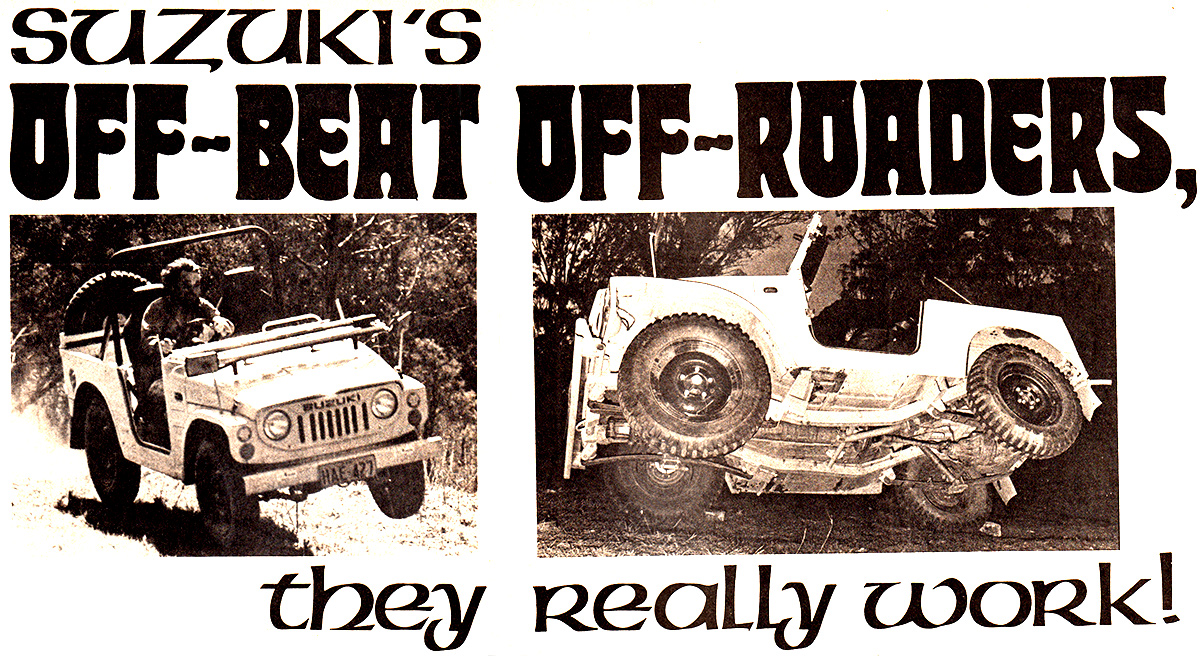Jimny history – how we got here (an Australian perspective)
There’s always a lot of divergence of opinion as we look backwards at history, but I wanted to collect a bunch of the articles and things relating to the Australian history of all things tiny Suzuki 4wds. To a large degree a generation 4 Jimny leans heavily on its heritage – not just on its styling, but its underpinnings – so understanding how we got here is useful to understand why things are how they are.
This piece of research leans heavily on journalistic sources of the time. I used the National Library’s wonderful Trove tool to dive back into newspapers and magazines, as well as sourced some physical magazines myself. I have reproduced this work here as fair dealings under Australian copyright for research/study, criticism/review and also they relate to news reporting in newspapers and periodicals. If you believe material you are a copyright holder for has been unfairly reproduced, I can be contacted through the Team Ghetto Racing group on Facebook in the first instance.
This page is very image heavy, but I wanted to reproduce the articles in their basic form; some have had some minor reformatting to make them fit the page better.
Sections
- Generation 1 (1970-1981)
- Generation 2 (1981-1998)
- Generation 3 (1998-2018)
- Generation 4 (2019- )
- Comparisons between generations
Generation 1 (1970-1981)

The first generation of Jimnys begins in 1970 with the LJ10; I couldn’t find evidence of it directly being brought in but the LJ20 was here in the early 70s, with the official launch of the model coming with the LJ50 in 1975. The larger LJ80 came to round out the model run through to 1981.
Generation 2 (1981-1998)

The quest for more power and better road manners was addressed by the update to the generation 2, the Sierra or SJ Jimnys. Staring off with a 1L engine, the engine then grew to 1.3L in 1985; accompanying this more wheelbases and body styles abounded and even a tie-in with Holden to rebadge the Sierra as the Drover occurred. Spanning 17 years, the last 2 years of the run saw an introduction of coil springs producing the ‘coily’; hotly debated amongst Sierra fans are the relative merits of the leafs versus the coils on and off road. This underpinned (quite literally) the transition to generation 3 in 1998.
Generation 3 (1998-2018)
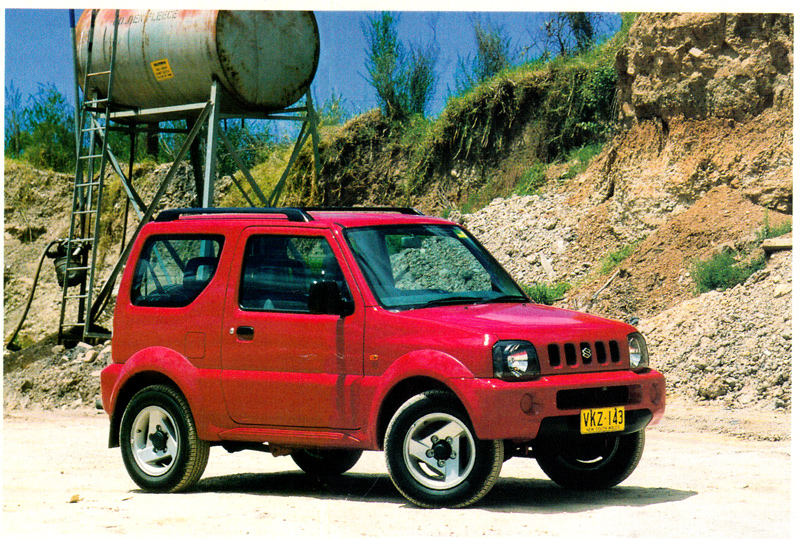
Generation 3 represented a style departure from the first 2 generations although with many elements to harken back to the earlier cars. It could also be seen to be a move to directly compete with Toyota’s wildly successful first generation Rav 4. This style departure was underpinned by significant re-engineering underneath, and brought with it more modern safety (airbags, ABS, and eventually ESP) along with better fuel efficiency. The car market, however, had moved to different styles of 4wds with a plethora of ‘lifted hatchbacks’ filling the small SUV segment, and the 3rd generation sold steadily but not at a rapid pace of the previous two generations of cars.
Generation 4 (2019- )
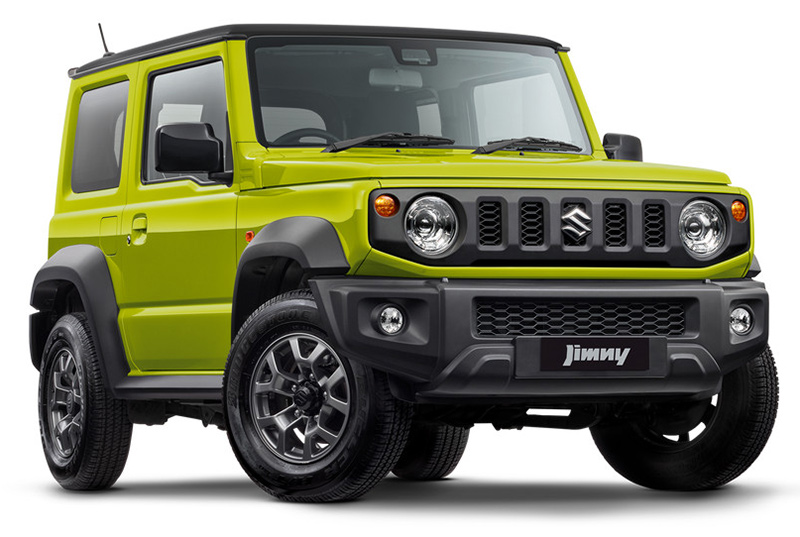
A major styling departure and bringing much more modern safety features to the fore, the generation 4 Jimny built upon the foundations of the 3rd generation with revisions in terms of powertrains and interior and exterior designs. Some re-engineering also occurred to strengthen key parts of the car. With retro styling becoming a key automotive trend as people harken for simpler times, the introduction of this generation brought sales success.
Generational comparisons
Pricing across generations
This is a huge can of worms, especially as most reported pricing is exclusive of taxes, on road costs, dealer delivery fees and the like. The primary source of this data is Redbook, but I have verified major RRP pricepoints with primary sourced publications like those shown above.
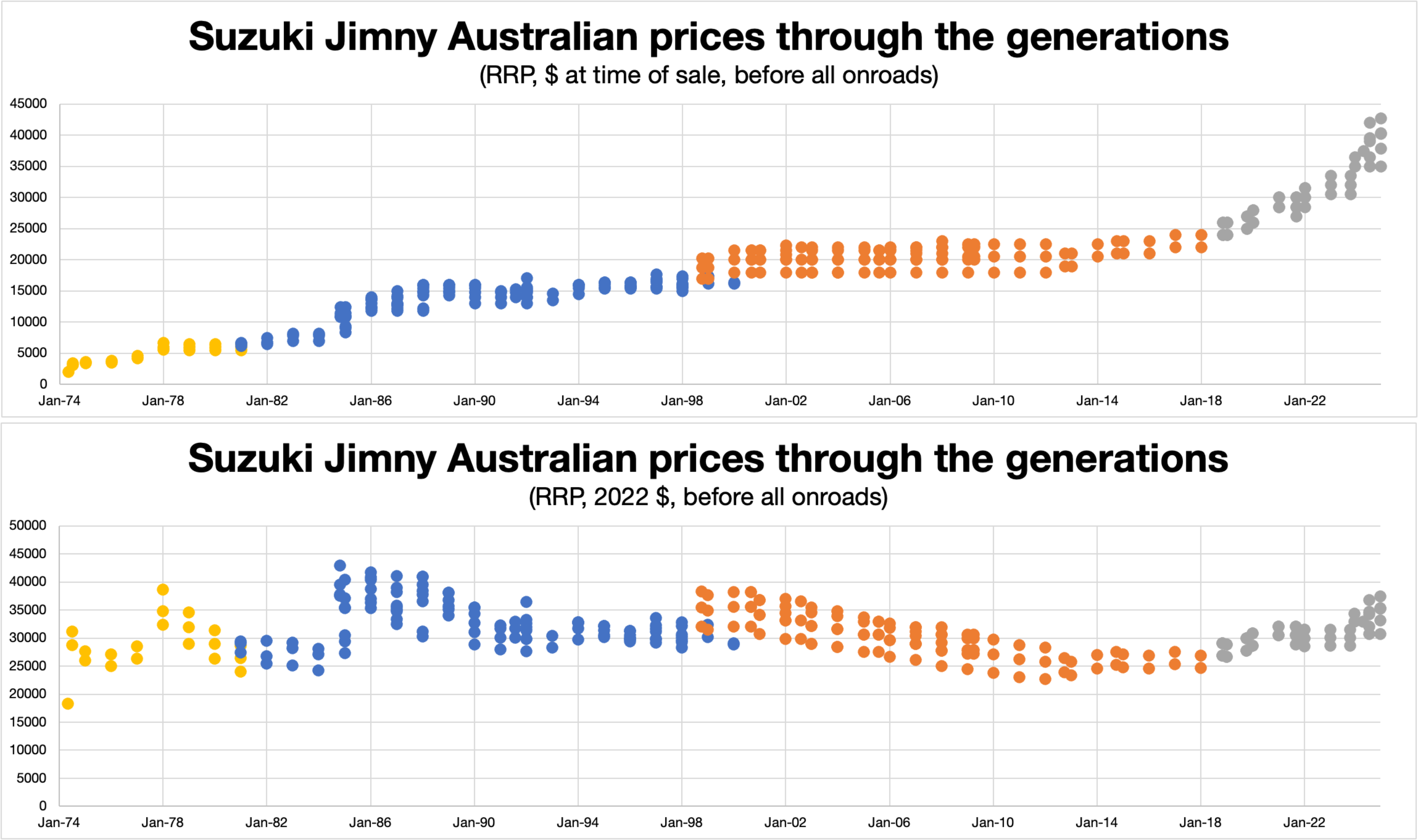
Some of these price differences are surprising. The static generation 3 prices is a bit offset by the narrowing of the range over the years e.g. dropping some of the lower-spec models, and the price crept up after the introduction of ESP. Some of the largest jumps were at the introduction of either a new model (e.g. LJ80) or significant revisions (such as introducing the 1300 cc Sierra). The latest RRP becomes squirrely for the gen4 cars, and, it is likely that earlier on people were not always paying RRP but with supply far under demand for gen4 cars, it is less likely this sort of discounting happens. On-road costs have also significantly increased & I haven’t accounted for colour options, either.
Sales over the years (Australia)
This is a lot harder to track for all generations, but it’s doable for generation 3 and 4 at least through VFACTS data:
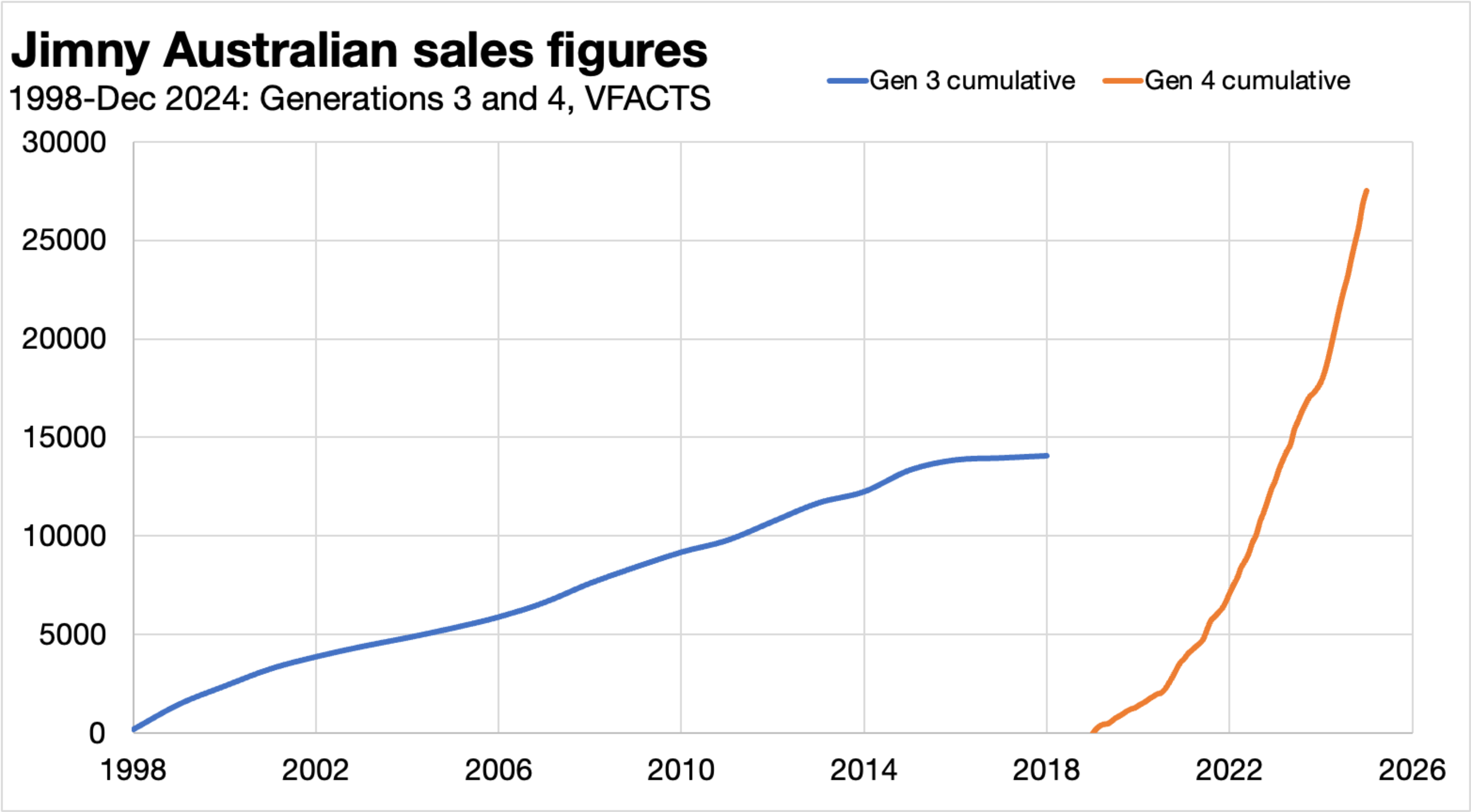
This shows the 4th generation Jimnys outselling the 3rd generation cars by a factor of 7.5 in Australia in terms of sales rates. Generation 4 cars have sold at an average rate of 5300 units a year to the end of 2024, and generation 3 sold an average 700 units per year over its lifespan.
What’s amazing is the sales growth for the 4th generation cars, in line with increasing supply, has occurred on the backdrop of tougher global economic conditions & higher pricing year-on-year for the car.
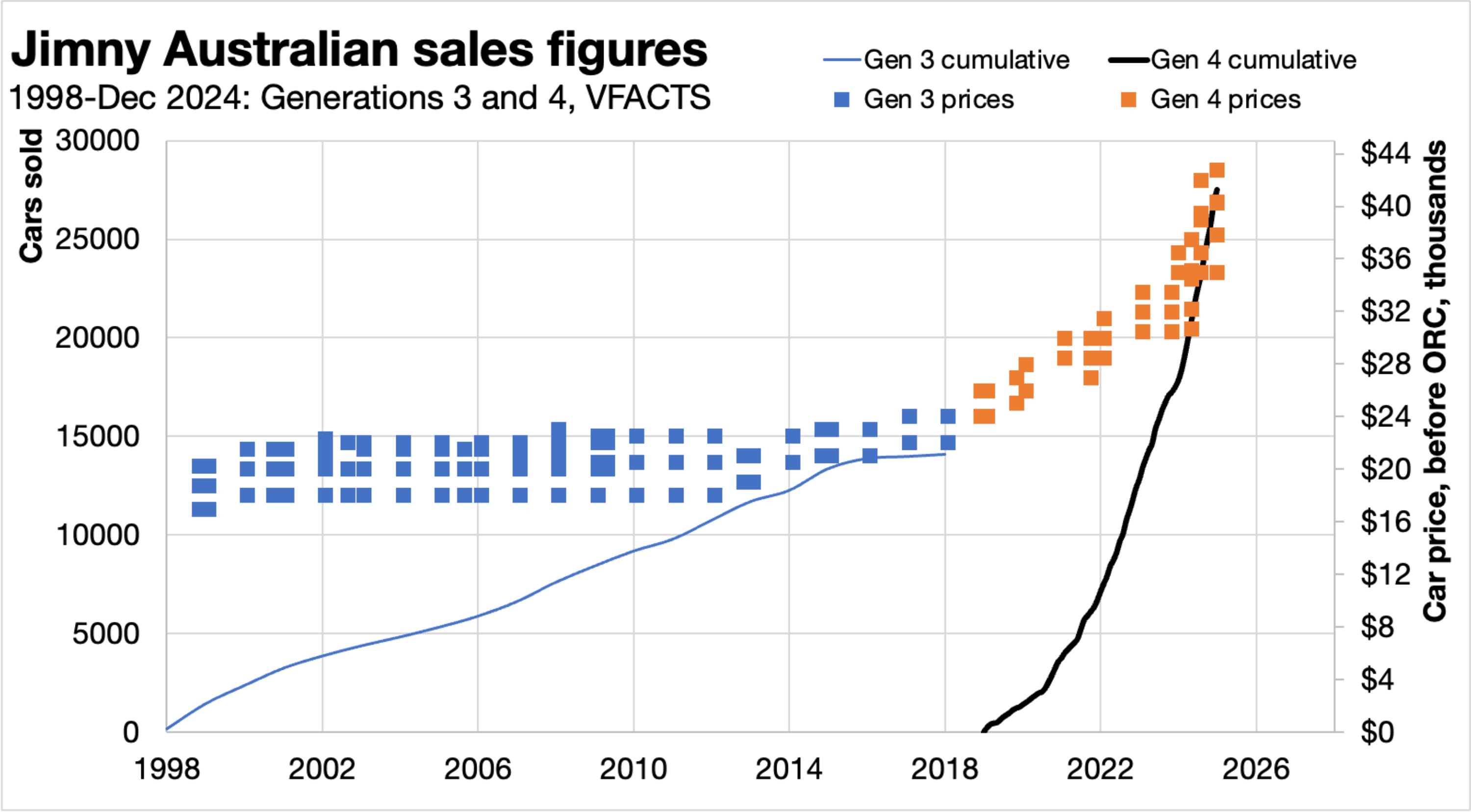
Australian sales data is harder to come by such data for the earlier cars so I can’t really reliably track it throughout history.
In one of the generation 1 LJ articles I sourced it is noted ~25 000 cars were sold from the 70s till 1981 in Australia, and we have firm sales figures for generations 3 and 4. I’ve not been able to source quite the same info for Sierras, however. The ‘Automotive Census’ for Australia, 1995 figures gives out figures for Suzuki ‘Light commercial vehicles’:
| < 1978 | 1979-1982 | 1983-1986 | 1987-1989 | 1990-1991 | 1992-1993 | 1994 | 1995 | No year | Total |
|---|---|---|---|---|---|---|---|---|---|
| 4044 | 14695 | 17809 | 4808 | 10001 | 625 | 646 | 227 | 160 | 44015 |
These data might suggest sales for Australia for gen2 of over 40 000 cars, assuming they are all classed as ‘light commercial vehicles’ – the methodology suggests they probably are, and this isn’t just the ute variants. Note that these are cars registered as at May 1995; some would have already been de-registered, and they continued to be sold up until 1997 (or 1999 for soft top and ute variants).
Another way to look likely total gen2 sales for Australia is estimating off the worldwide total numbers (discussed below). The generation 2 cars globally sold 1.85x as many as generation 3, so perhaps 32 thousand Sierras were sold in Australia if you use gen3 sales #s as a base. The alternative estimate, also based on worldwide total numbers, is that Sierras outsold LJs about 7.9x. This would imply an upper bound on Australian Sierra sales of nearly 200 thousand cars. This number might indeed be roughly in line with the 5% of the 4wd market seen in some contemporary press figures. No matter how you estimate it the small Suzuki offroads are incredibly popular in Australia and have been so since launch.
| Generation | Start | End | Australian total sales |
|---|---|---|---|
| 1 | 1974 | 1980 | ~25 000 |
| 2 | 1981 | 1998 | Likely: 40 000 – 60 000 (but 32 000 -> 200 000 depending on how you estimate it) |
| 3 | 1998 | 2018 | 14 077 |
| 4 | 2019 | In production (figures to December 2024) | 27 527 |
International sales
Worldwide, the media kit provided by Suzuki Australia provides the following figures:
- Generation 1: 243 thousand (over 11 years: ~22k units per year)
- Generation 2: 1.693 million (over 17 years: ~100k units per year)
- Generation 3: 918 thousand (over 20 years: ~46k units per year)
Combining this data with total units sold (from media kits for other countries) and, since 2014, monthly sales data, you arrive at the following:
| Generation | Start | End | Cumulative sales |
|---|---|---|---|
| 1 | 1970 | 1980 | 243 000 |
| 2 | 1981 | 1998 | 1 693 000 |
| 3 | 1998 | 2018 | 918 000 |
| 4 | 2018 (Japan) late 2018 – early 2019 (rest of world) | In production (figures to ~end 2024) | 513 121 |
Global sales data indicates that, at the end of 2024, there is a sales rate for generation 4 of about 86k units per year i.e. roughly double generation 3 sales.
The sales history globally for the past ~55 years is as follows:
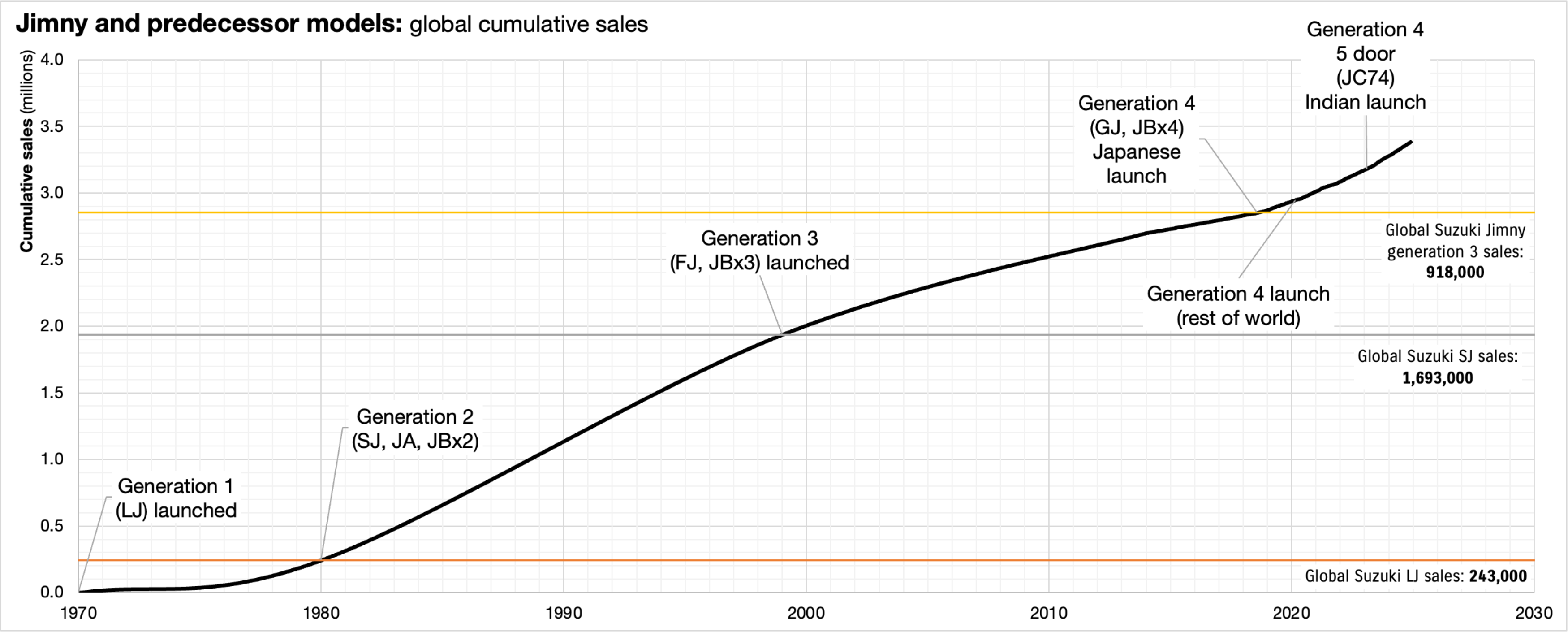
Specs over the years
Rather than just have a big giant table, I thought I’d look at graphs of how some of the key specifications changed over time, e.g. how has power, kerb weight and power to weight ratios changed through time.
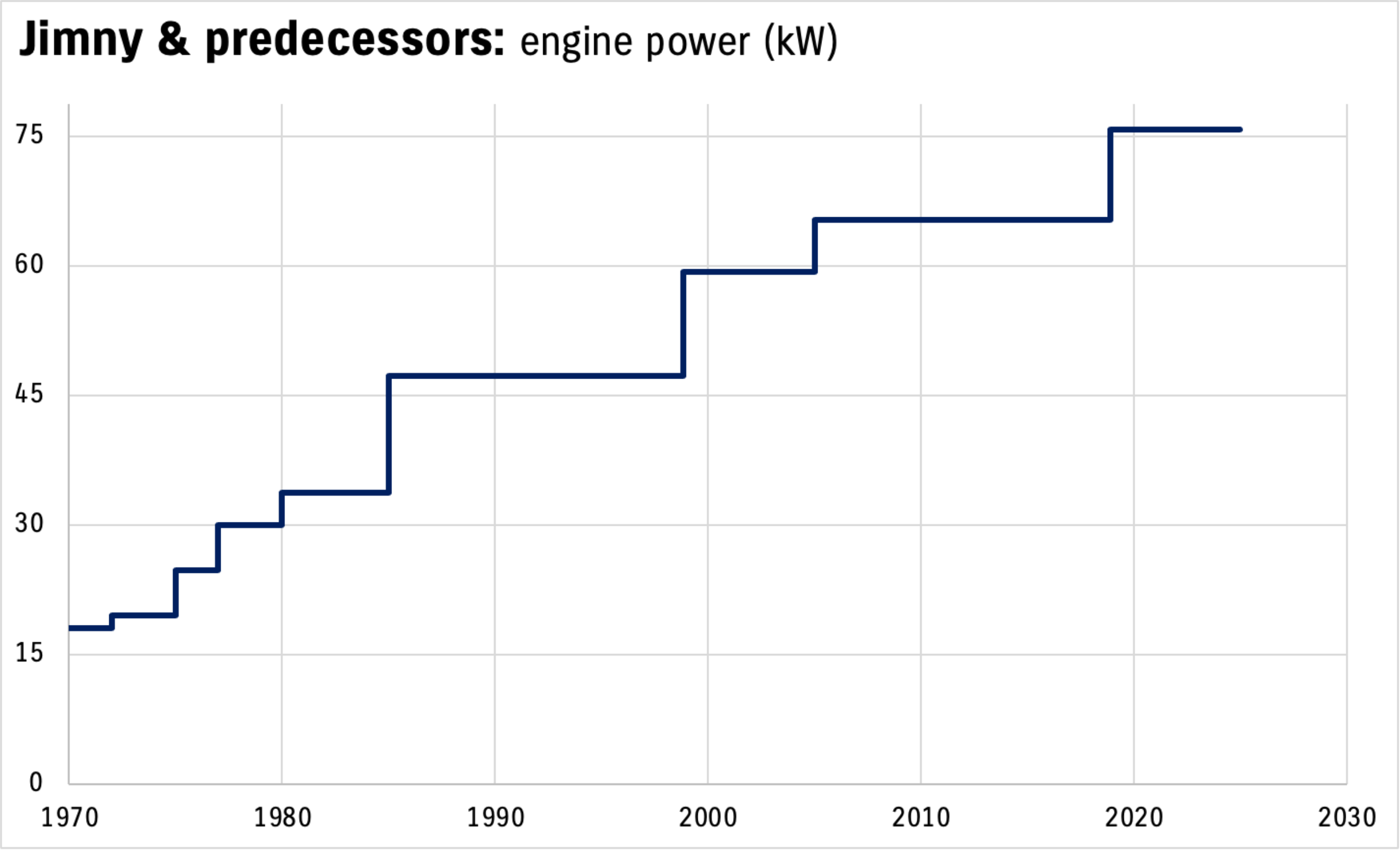
The interesting thing is how weights have grown: the earlier cars, being incredibly basic, were super light. On the flipside, a ~1100 kg modern car these days is regarded as still pretty light. One of the interesting things that jumped out is the weight change from a leaf to a coil sprung Sierra, just prior to the introduction of the 3rd generation Jimny. This isn’t necessarily unexpected as the bodywork, parts of the chassis and obviously the suspension changed but it was still a surprise. (There’s also the possibility that numbers are wrong for earlier cars, too).
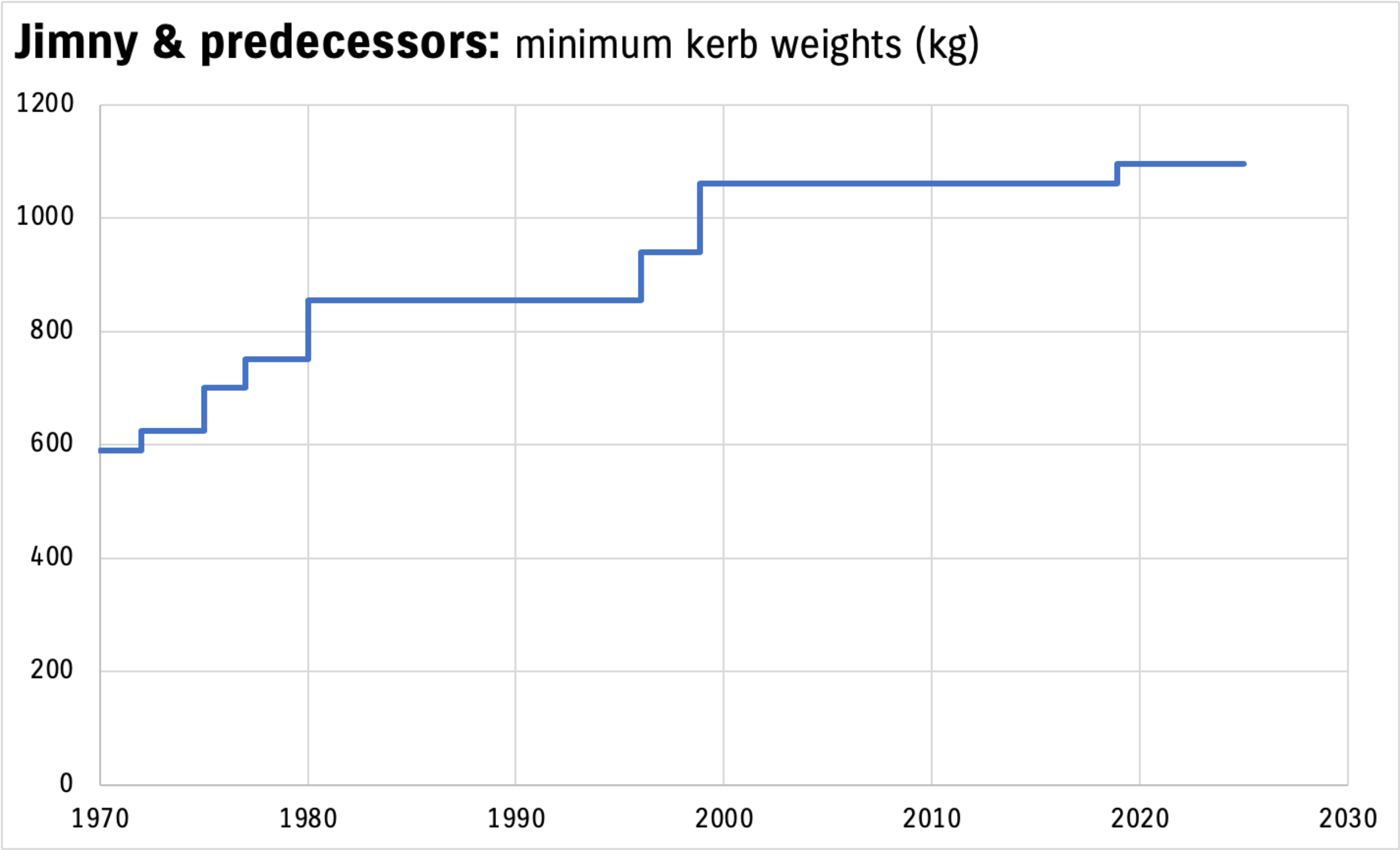
A final interesting thing to look at is the power to GVM. I have gone with the minimum GVM here (as I did with the kerb weight). A 5 door generation 4 Jimny would have a power to GVM ratio similar to a gen3 Jimny just purely based on the ~100 kg heavier its GVM is.
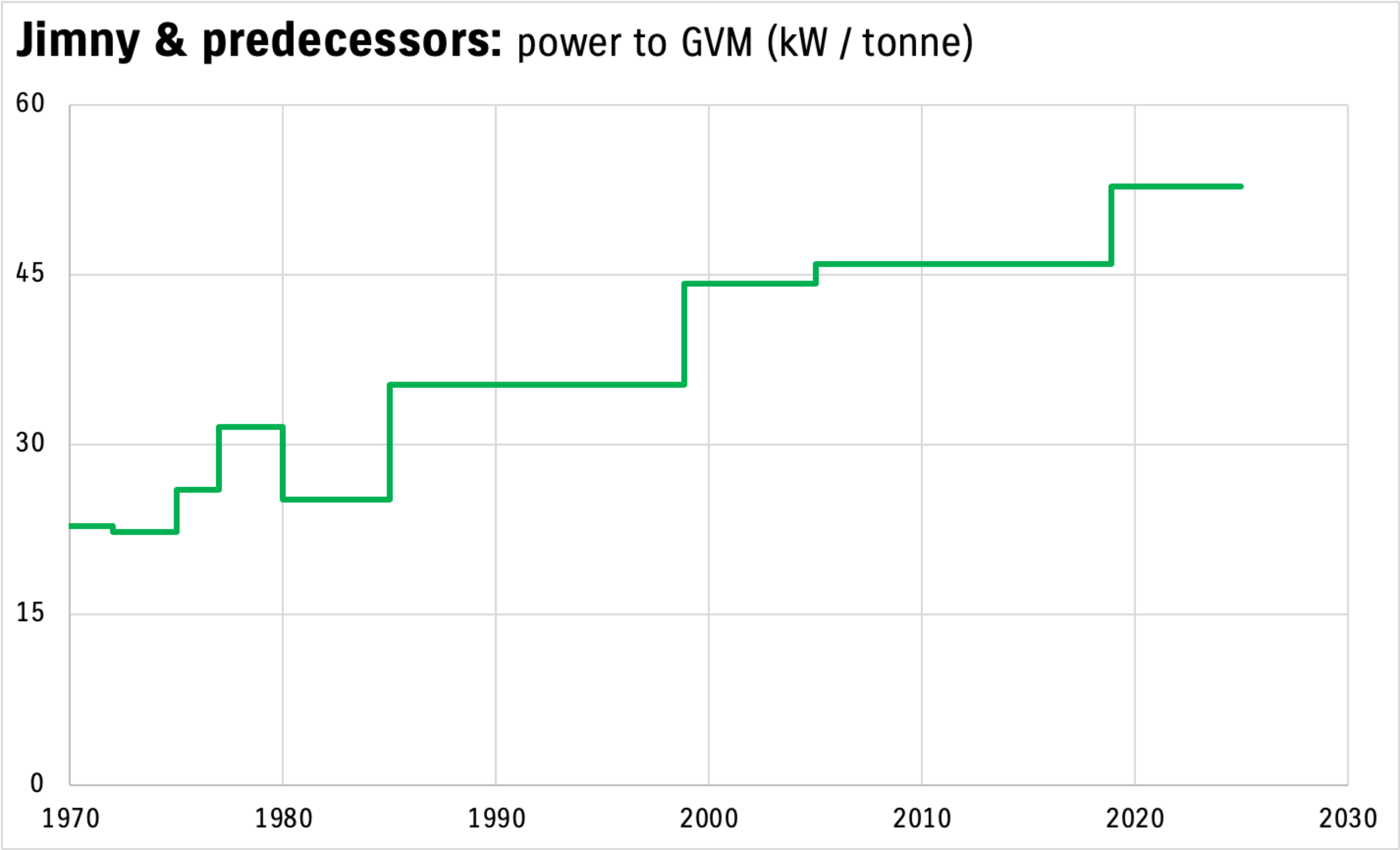
As a summary, major jumps in specification occurred at a few changepoints. What follows are for Australian cars:
- Larger engine came in 1975 with the LJ50
- 4 stroke 800cc engine in the LJ80 arrived in 1978
- 1L engine (but still with a 4 speed manual) in 1980 with the launch of the SJ series
- 1.3L engine and 5 speed transmission arrived late 1984/early 1985
- Coil suspension for Sierras arrived in 1996 for the last couple of years of generation 2
- The Stockman (trayback ute on long wheel base Maruti chassis) continued into generation 3, to the turn of the millenium
- ABS, an airbag, automatic transmissions plus a development of the manual, arrived with the Jimny (generation 3) in 1998
- Revised engine (M13A instead of G13BB) in 2005
- Low specification (JX) dropped in favour of just the higher specification (JLX) and the introduction of ESP in 2014/2015
- November 2018 saw the launch of the 1.5L engine generation 4 Jimny

